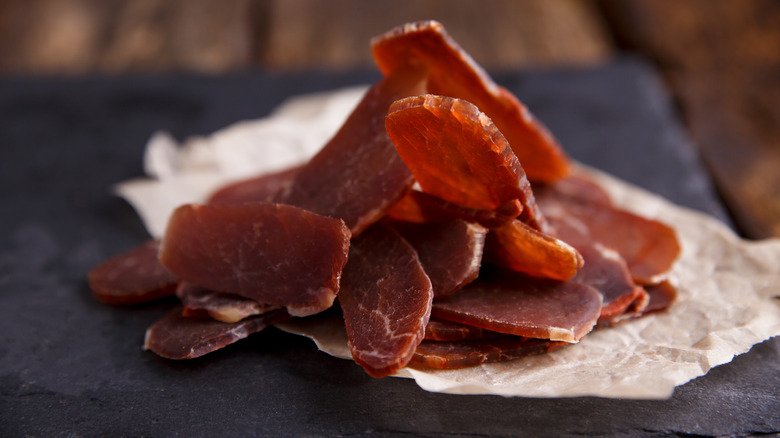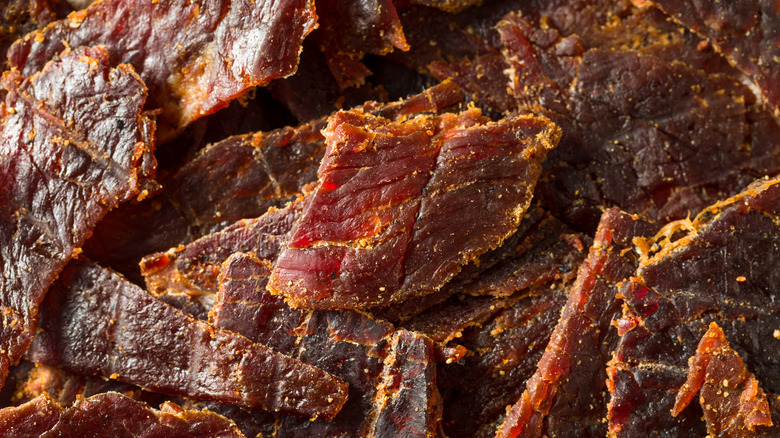How Archaeologists Discovered 2,000-Year-Old Beef Jerky In China
Have you ever walked through the snack aisle of a gas station convenience store and wondered what our ancient ancestors would think of its plastic-packed denizens? Imagine Cleopatra ripping open a bag of Flamin' Hot Cheetos; Marcus Aurelius picking through a bowl of Chex Mix; or Homer capping off his supper with a handful of Sour Patch Kids. In each of these fantasies, you're probably picturing looks of utter confusion on the faces of these historical figures as their taste buds struggle to adapt to the chemically enhanced flavors of mass-produced 21st-century foodstuffs.
But there's at least one item in that aisle that's been around for longer than you'd think: beef jerky. Popular legend has it that the Spanish Conquistadors made a name for the savory, toothsome treat in the 1500s after learning a Native American technique for drying meat, per Liberty Cattle Company. And according to recent archeological findings, people in ancient China were also making their own version of jerky.
A two-year excavation in the Shaanxi Province
In 2009, a Chinese archaeological institute began a two-year excavation in the country's Shaanxi Province, where they made all sorts of fascinating discoveries. According to paleontologist Hu Songmei, one of them was a bronze pot containing 2,000-year-old dried beef, which was indeed an early form of beef jerky. Hu told China.org that the beef has been resting in its tomb in the village of Wanli since the Warring States Period (475 B.C. – 221 B.C.). The jerky had taken on a fuzzy green-black hue over time due to carbonization, but no shrinkage had occurred since its original drying.
It's possible that the meat was used for sweet and salty bak kwa, which translates to "dried meat" in the Hokkien dialect and is often eaten during the Lunar New Year. A recipe in Malaysian Chinese Kitchen describes the dish as "wafer thin slices of barbecued pork jerky," adding that bak kwa is a little different from jerky in preparation. Rather than dehydrating the meat, bak kwa is "moist and grilled to perfection over charcoal fire."
The Singapore Food Agency suggests eating bak kwa within five to seven days of purchase, so you definitely don't want to snack on any if you happen to find it in an ancient tomb.
Jerky as we know it
The first sign of jerky-like meat may predate ancient China, and it certainly predates 1500s Spain.
Crockett Creek relays popular findings that say one of the first iterations of the snack was eaten by Central America's Incan Civilization, whose Quechan word "ch'arki" translates to "dried meat," or "burning meat." The findings show that the Incan people sliced meat into thin strips that they salted and smoked before laying out to dry over a fire. Although, it's likely that they used llamas or alpacas, not cows.
While the Incan people were early adopters of the technique, they may have been inspired by an even earlier version. In 2015, Brian Bianchetti told People's Choice Beef Jerky that "the closest version to modern-day beef jerky" may have been invented by the ancient Native people of the Andes mountains, which is now Peru. "The unique climatic conditions of this high altitude region made the ancient jerky production possible," he said. The Quechuan word "ch'arki" gave way to the American word "jerky," along with the countless iterations of it today.


